24-08-07 HashSet与LinkedHashSet的底层机制与源码说明
文章目录
HashSet
初步认识HashSet
public class HashSet_ {
public static void main(String[] args) {
//老韩解读
//1. 构造器走的源码
/*
public HashSet() {
map = new HashMap<>();
}
2. HashSet 可以存放null ,但是只能有一个null,即元素不能重复
*/
Set hashSet = new HashSet();
hashSet.add(null);
hashSet.add(null);
System.out.println("hashSet=" + hashSet);
}
}
@SuppressWarnings({"all"})
public class HashSet01 {
public static void main(String[] args) {
HashSet set = new HashSet();
//说明
//1. 在执行add方法后,会返回一个boolean值
//2. 如果添加成功,返回 true, 否则返回false
//3. 可以通过 remove 指定删除哪个对象
System.out.println(set.add("john"));//T
System.out.println(set.add("lucy"));//T
System.out.println(set.add("john"));//F
System.out.println(set.add("jack"));//T
System.out.println(set.add("Rose"));//T
set.remove("john");
System.out.println("set=" + set);//3个
//
set = new HashSet();
System.out.println("set=" + set);//0
//4 Hashset 不能添加相同的元素/数据?
set.add("lucy");//添加成功
set.add("lucy");//加入不了
set.add(new Dog("tom"));//OK
set.add(new Dog("tom"));//Ok
System.out.println("set=" + set);
//在加深一下. 非常经典的面试题.
//看源码,做分析, 先给小伙伴留一个坑,以后讲完源码,你就了然
//去看他的源码,即 add 到底发生了什么?=> 底层机制.
set.add(new String("hsp"));//ok
set.add(new String("hsp"));//加入不了.
System.out.println("set=" + set);
}
}
class Dog { //定义了Dog类
private String name;
public Dog(String name) {
this.name = name;
}
@Override
public String toString() {
return "Dog{" +
"name='" + name + '\'' +
'}';
}
}
数组链表模拟
hashset的底层实际上是hashmap,hashmap的底层是数组加链表加红黑树。
public class HashSetStructure {
public static void main(String[] args) {
//模拟一个HashSet的底层 (HashMap 的底层结构)
//1. 创建一个数组,数组的类型是 Node[]
//2. 有些人,直接把 Node[] 数组称为 表
Node[] table = new Node[16];
//3. 创建结点
Node john = new Node("john", null);
table[2] = john;
Node jack = new Node("jack", null);
john.next = jack;// 将jack 结点挂载到john
Node rose = new Node("Rose", null);
jack.next = rose;// 将rose 结点挂载到jack
Node lucy = new Node("lucy", null);
table[3] = lucy; // 把lucy 放到 table表的索引为3的位置.
System.out.println("table=" + table);
}
}
class Node { //结点, 存储数据, 可以指向下一个结点,从而形成链表
Object item; //存放数据
Node next; // 指向下一个结点
public Node(Object item, Node next) {
this.item = item;
this.next = next;
}
}
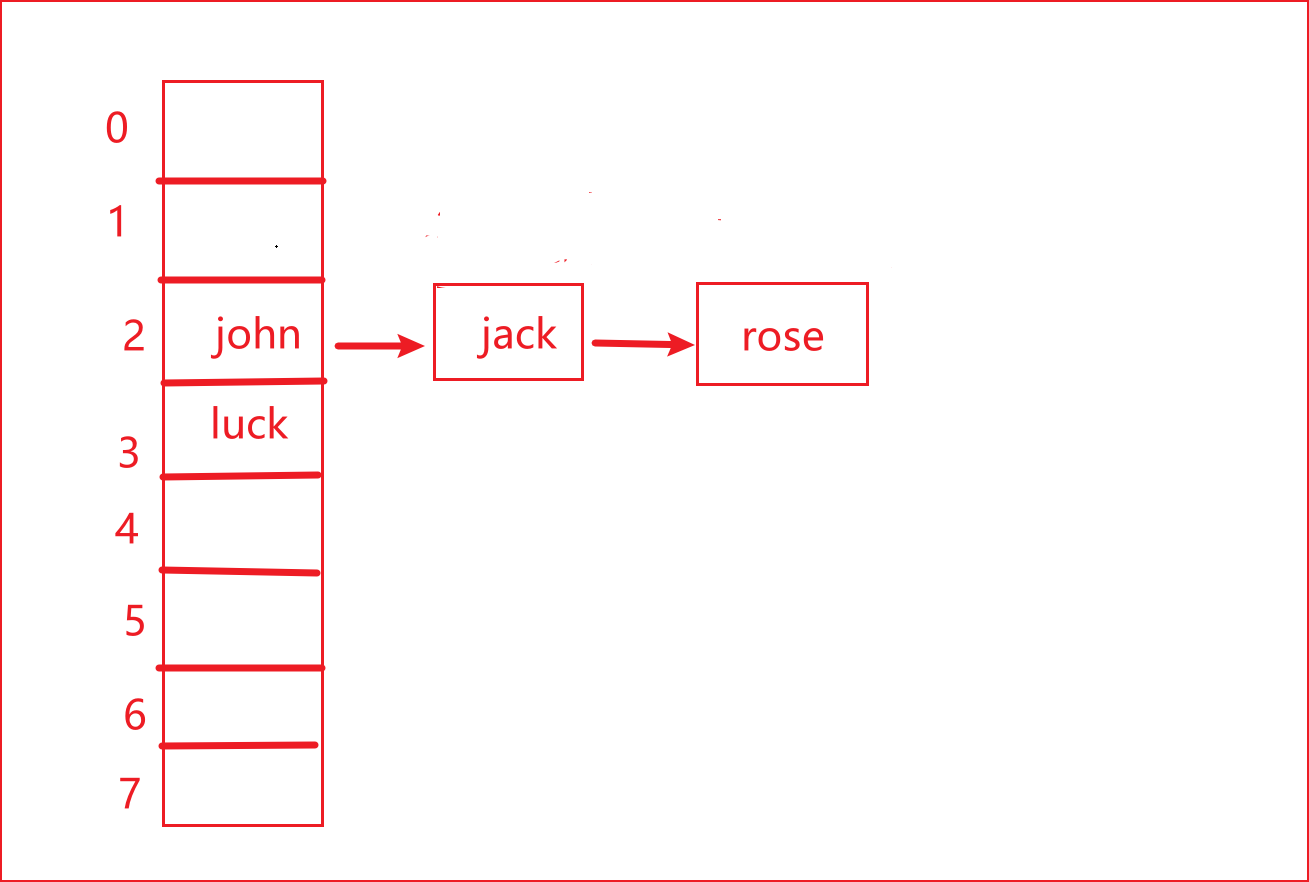
HashSet的扩容机制
第一次扩容大小为16,加载因子为0.75,临界值为12.此后每扩容一次,大小乘2倍。
HashSet的源码解析
@SuppressWarnings({"all"})
public class HashSetSource {
public static void main(String[] args) {
HashSet hashSet = new HashSet();
hashSet.add("java");
hashSet.add("php");
hashSet.add("java");
//哈希码是一种可以唯一标识一个对象的整数值,通常用于哈希表等数据结构中。
}
}
1. 执行 HashSet()
public HashSet() {
map = new HashMap<>();
}

2. 执行 add()
public boolean add(E e) {//e = "java"
return map.put(e, PRESENT)==null;//(static) PRESENT = new Object();
}
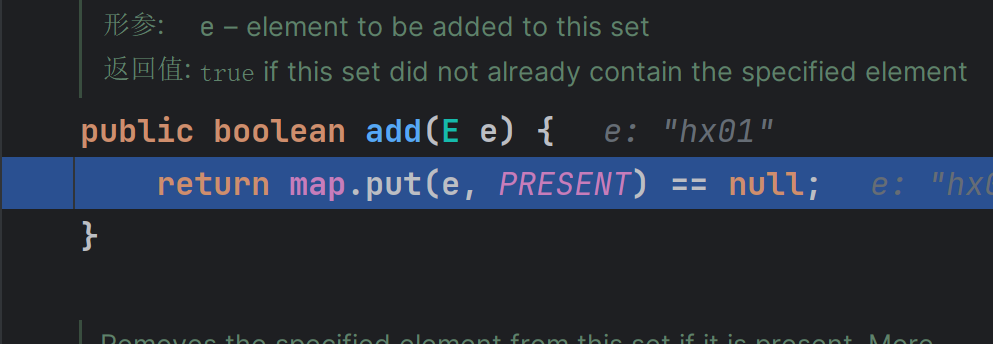
3.执行 put() , 该方法会执行 hash(key) 得到key对应的hash值 算法h = key.hashCode()) ^ (h >>> 16)
public V put(K key, V value) {//key = "java" value = PRESENT 共享
return putVal(hash(key), key, value, false, true);
}


4.执行 putVal
final V putVal(int hash, K key, V value, boolean onlyIfAbsent,
boolean evict) {
Node<K,V>[] tab; Node<K,V> p; int n, i; //定义了辅助变量
//table 就是 HashMap 的一个数组,类型是 Node[]
//if 语句表示如果当前table 是null, 或者 大小=0
//就是第一次扩容,到16个空间.
if ((tab = table) == null || (n = tab.length) == 0)
n = (tab = resize()).length;
//(1)根据key,得到hash 去计算该key应该存放到table表的哪个索引位置
//并把这个位置的对象,赋给 p
//(2)判断p 是否为null
//(2.1) 如果p 为null, 表示还没有存放元素, 就创建一个Node (key="java",value=PRESENT)
//(2.2) 就放在该位置 tab[i] = newNode(hash, key, value, null)
if ((p = tab[i = (n - 1) & hash]) == null)
tab[i] = newNode(hash, key, value, null);
else {
//一个开发技巧提示: 在需要局部变量(辅助变量)时候,在创建
Node<K,V> e; K k; //
//如果当前索引位置对应的链表的第一个元素和准备添加的key的hash值一样
//并且满足 下面两个条件之一:
//(1) 准备加入的key 和 p 指向的Node 结点的 key 是同一个对象
//(2) p 指向的Node 结点的 key 的equals() 和准备加入的key比较后相同
//就不能加入
if (p.hash == hash &&
((k = p.key) == key || (key != null && key.equals(k))))
e = p;
//再判断 p 是不是一颗红黑树,
//如果是一颗红黑树,就调用 putTreeVal , 来进行添加
else if (p instanceof TreeNode)
e = ((TreeNode<K,V>)p).putTreeVal(this, tab, hash, key, value);
else {//如果table对应索引位置,已经是一个链表, 就使用for循环比较
//(1) 依次和该链表的每一个元素比较后,都不相同, 则加入到该链表的最后
// 注意在把元素添加到链表后,立即判断 该链表是否已经达到8个结点
// , 就调用 treeifyBin() 对当前这个链表进行树化(转成红黑树)
// 注意,在转成红黑树时,要进行判断, 判断条件
// if (tab == null || (n = tab.length) < MIN_TREEIFY_CAPACITY(64))
// resize();
// 如果上面条件成立,先table扩容.
// 只有上面条件不成立时,才进行转成红黑树
//(2) 依次和该链表的每一个元素比较过程中,如果有相同情况,就直接break
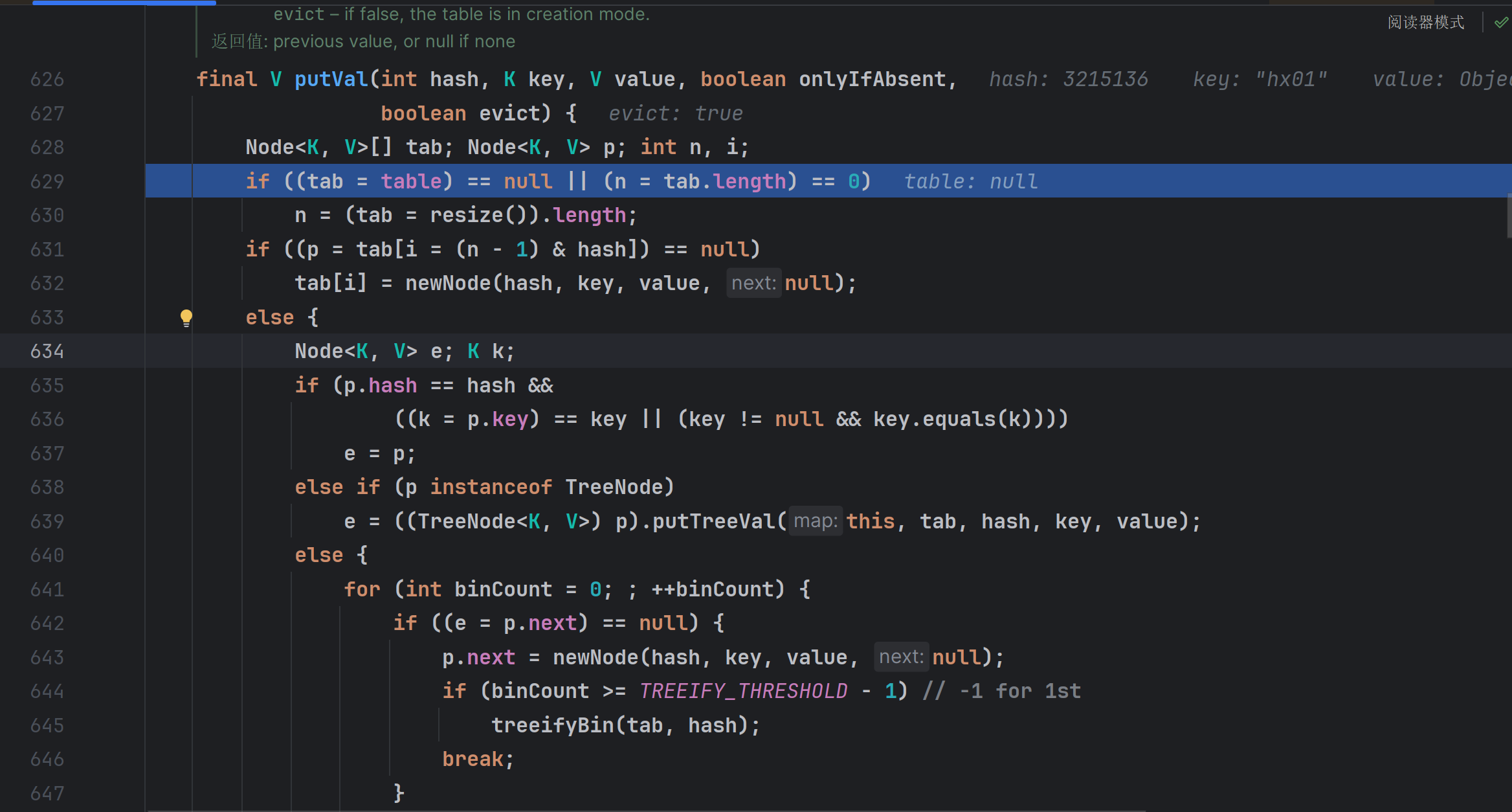

public class HashSetIncrement {
public static void main(String[] args) {
/*
HashSet底层是HashMap, 第一次添加时,table 数组扩容到 16,
临界值(threshold)是 16*加载因子(loadFactor)是0.75 = 12
如果table 数组使用到了临界值 12,就会扩容到 16 * 2 = 32,
新的临界值就是 32*0.75 = 24, 依次类推
*/
HashSet hashSet = new HashSet();
// for(int i = 1; i <= 100; i++) {
// hashSet.add(i);//1,2,3,4,5...100
// }
/*
在Java8中, 如果一条链表的元素个数到达 TREEIFY_THRESHOLD(默认是 8 ),
并且table的大小 >= MIN_TREEIFY_CAPACITY(默认64),就会进行树化(红黑树),
否则仍然采用数组扩容机制
*/
// for(int i = 1; i <= 12; i++) {
// hashSet.add(new A(i));//
// }
/*
当我们向hashset增加一个元素,-> Node -> 加入table , 就算是增加了一个size++
*/
for(int i = 1; i <= 7; i++) {//在table的某一条链表上添加了 7个A对象
hashSet.add(new A(i));//
}
for(int i = 1; i <= 7; i++) {//在table的另外一条链表上添加了 7个B对象
hashSet.add(new B(i));//
}
}
}
class B {
private int n;
public B(int n) {
this.n = n;
}
@Override
public int hashCode() {
return 200;
}
}
class A {
private int n;
public A(int n) {
this.n = n;
}
@Override
public int hashCode() {
return 100;
}
}
HashSet练习题
public class HashSetExercise {
public static void main(String[] args) {
Employee xiaoming = new Employee("xiaoming", 10000,new MyDate(2005,9,25));
Employee xiaohong = new Employee("xiaohong", 5000,new MyDate(2004,8,23));
Employee xiaofang = new Employee("xiaoming", 1000,new MyDate(2005,9,25));
HashSet hashSet = new HashSet();
hashSet.add(xiaofang);
hashSet.add(xiaoming);
hashSet.add(xiaohong);
System.out.println(hashSet);
}
}
class Employee {
private String name;
private double sal;
private MyDate birthday;
public Employee(String name, double sal, MyDate birthday) {
this.name = name;
this.sal = sal;
this.birthday = birthday;
}
@Override
public boolean equals(Object object) {
if (this == object) return true;
if (object == null || getClass() != object.getClass()) return false;
Employee employee = (Employee) object;
return Objects.equals(name, employee.name) && Objects.equals(birthday, employee.birthday);
}
@Override
public int hashCode() {
return Objects.hash(name, birthday);
}
@Override
public String toString() {
return "Employee{" +
"name='" + name + '\'' +
", sal=" + sal +
", birthday=" + birthday +
'}';
}
}
class MyDate {
private int year, month, day;
public MyDate(int year, int month, int day) {
this.year = year;
this.month = month;
this.day = day;
}
@Override
public String toString() {
return "MyDate{" +
"year=" + year +
", month=" + month +
", day=" + day +
'}';
}
@Override
public boolean equals(Object object) {
if (this == object) return true;
if (object == null || getClass() != object.getClass()) return false;
MyDate myDate = (MyDate) object;
return year == myDate.year && month == myDate.month && day == myDate.day;
}
@Override
public int hashCode() {
return Objects.hash(year, month, day);
}
}
LinkedHashSet
LinkedHashSet的初步介绍
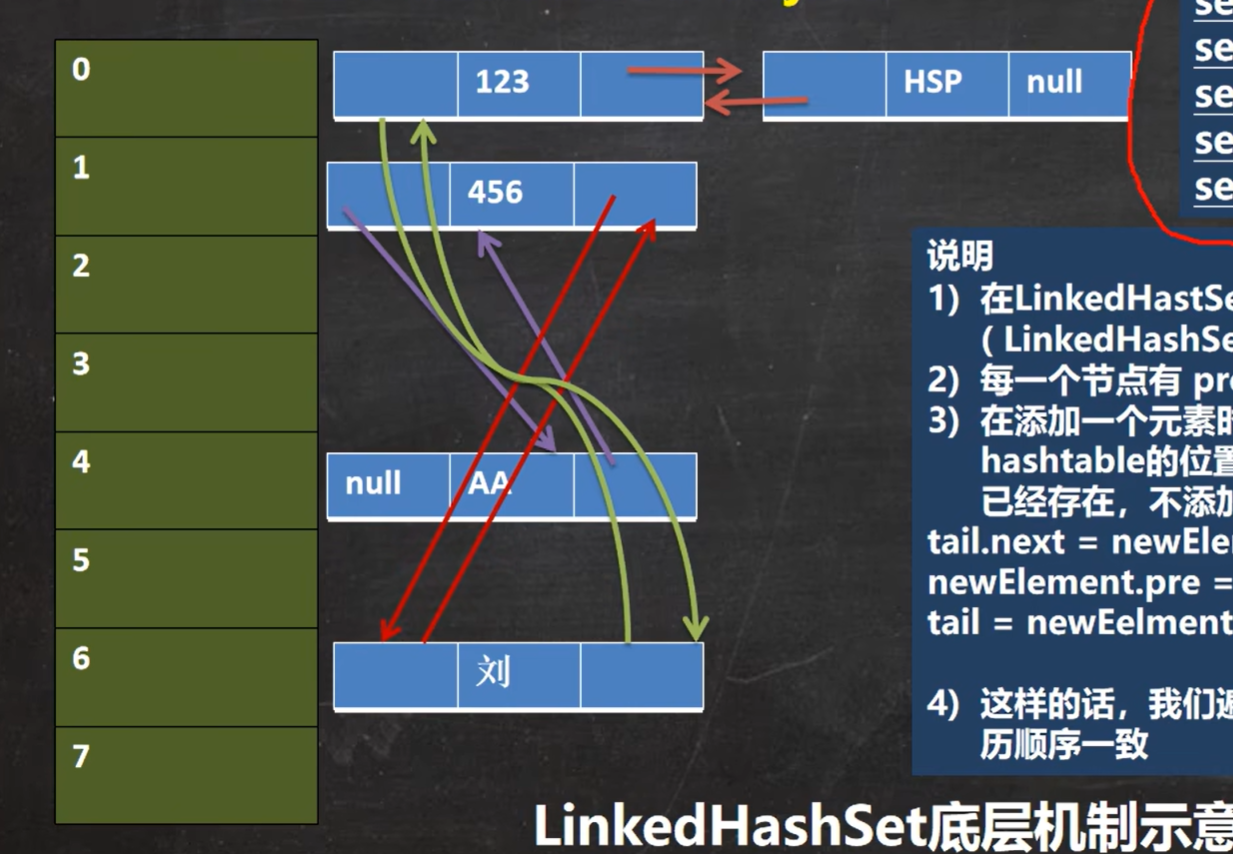
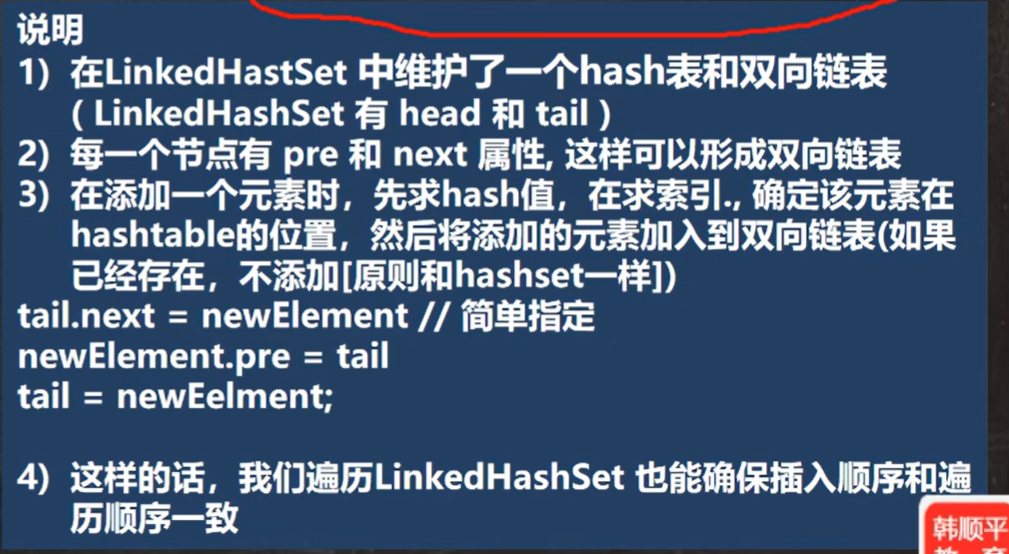
LinkedHashSet的源码解析
@SuppressWarnings({"all"})
public class LinkedHashSetSource {
public static void main(String[] args) {
//分析一下LinkedHashSet的底层机制
Set set = new LinkedHashSet();
set.add(new String("AA"));
set.add(456);
set.add(456);
set.add(new Customer("刘", 1001));
set.add(123);
set.add("HSP");
System.out.println("set=" + set);
//老韩解读
//1. LinkedHashSet 加入顺序和取出元素/数据的顺序一致
//2. LinkedHashSet 底层维护的是一个LinkedHashMap(是HashMap的子类)
//3. LinkedHashSet 底层结构 (数组table+双向链表)
//4. 添加第一次时,直接将 数组table 扩容到 16 ,存放的结点类型是 LinkedHashMap$Entry
//5. 数组是 HashMap$Node[] 存放的元素/数据是 LinkedHashMap$Entry类型
/*
//继承关系是在内部类完成.
static class Entry<K,V> extends HashMap.Node<K,V> {
Entry<K,V> before, after;
Entry(int hash, K key, V value, Node<K,V> next) {
super(hash, key, value, next);
}
}
*/
}
}
class Customer {
private String name;
private int no;
public Customer(String name, int no) {
this.name = name;
this.no = no;
}
}
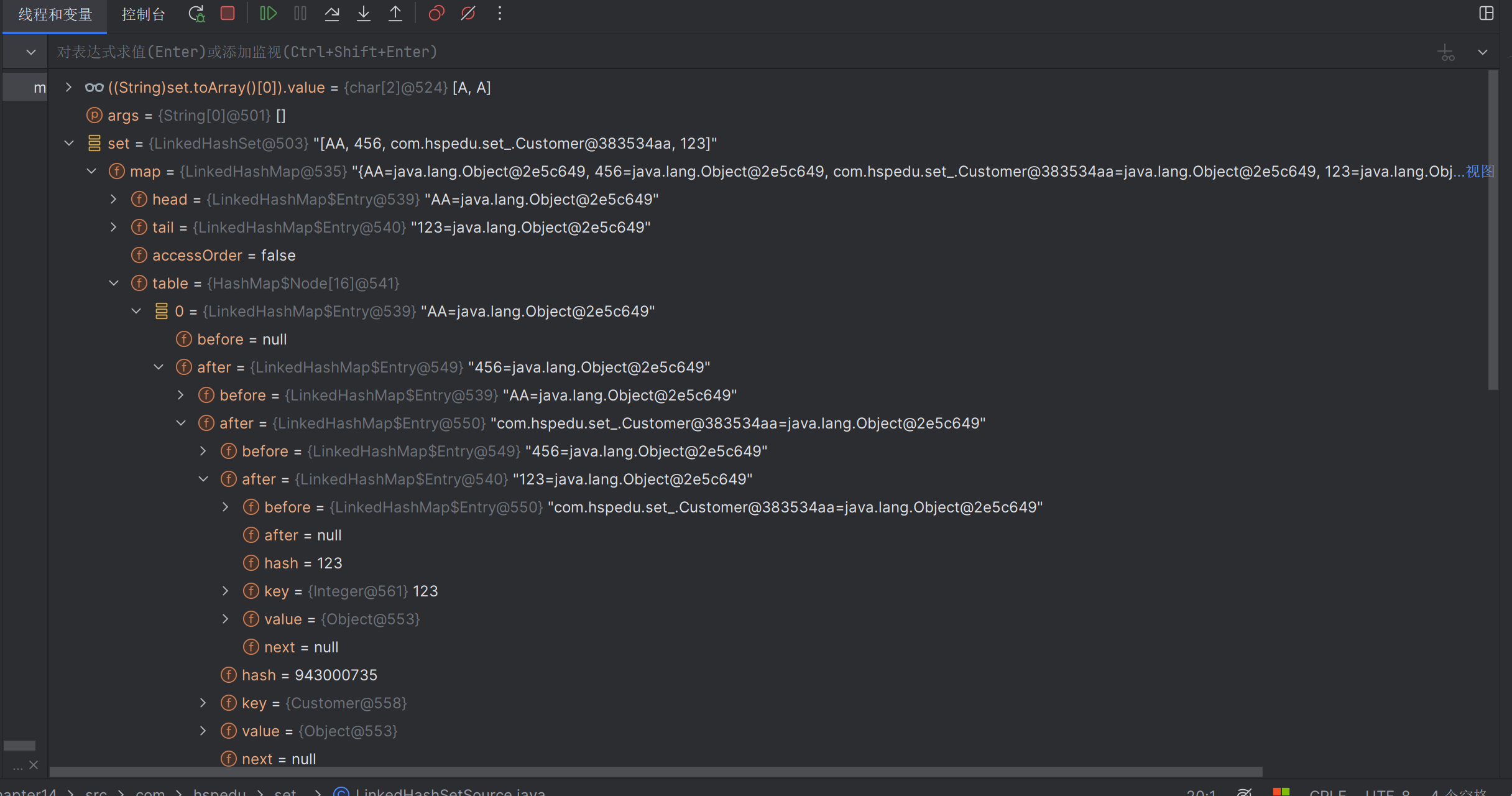
LinkHashSet练习题
public class LinkedHashSetExercise {
public static void main(String[] args) {
LinkedHashSet linkedHashSet = new LinkedHashSet();
linkedHashSet.add(new Car("奥拓", 1000));//OK
linkedHashSet.add(new Car("奥迪", 300000));//OK
linkedHashSet.add(new Car("法拉利", 10000000));//OK
linkedHashSet.add(new Car("奥迪", 300000));//加入不了
linkedHashSet.add(new Car("保时捷", 70000000));//OK
linkedHashSet.add(new Car("奥迪", 300000));//加入不了
System.out.println("linkedHashSet=" + linkedHashSet);
}
}
/**
* Car 类(属性:name,price), 如果 name 和 price 一样,
* 则认为是相同元素,就不能添加。 5min
*/
class Car {
private String name;
private double price;
public Car(String name, double price) {
this.name = name;
this.price = price;
}
public String getName() {
return name;
}
public void setName(String name) {
this.name = name;
}
public double getPrice() {
return price;
}
public void setPrice(double price) {
this.price = price;
}
@Override
public String toString() {
return "\nCar{" +
"name='" + name + '\'' +
", price=" + price +
'}';
}
//重写equals 方法 和 hashCode
//当 name 和 price 相同时, 就返回相同的 hashCode 值, equals返回t
@Override
public boolean equals(Object o) {
if (this == o) return true;
if (o == null || getClass() != o.getClass()) return false;
Car car = (Car) o;
return Double.compare(car.price, price) == 0 &&
Objects.equals(name, car.name);
}
@Override
public int hashCode() {
return Objects.hash(name, price);
}
}
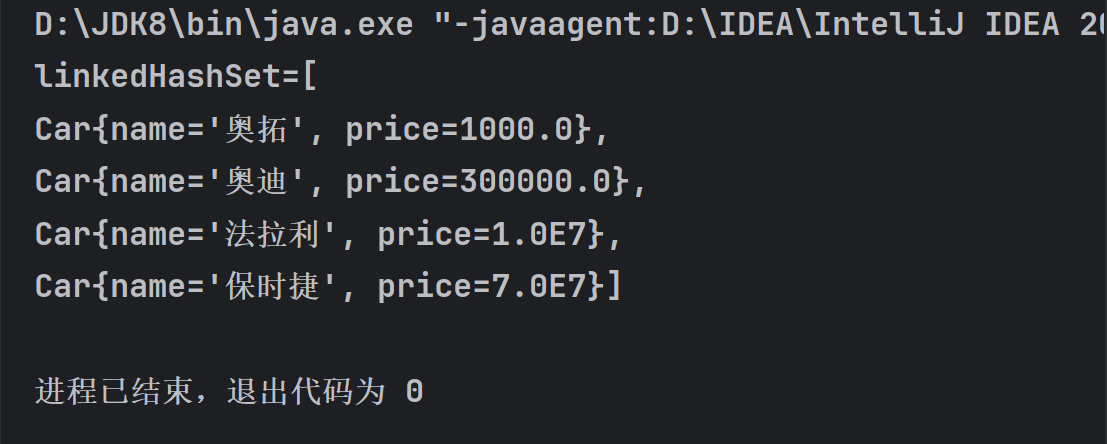





















 246
246

 被折叠的 条评论
为什么被折叠?
被折叠的 条评论
为什么被折叠?








